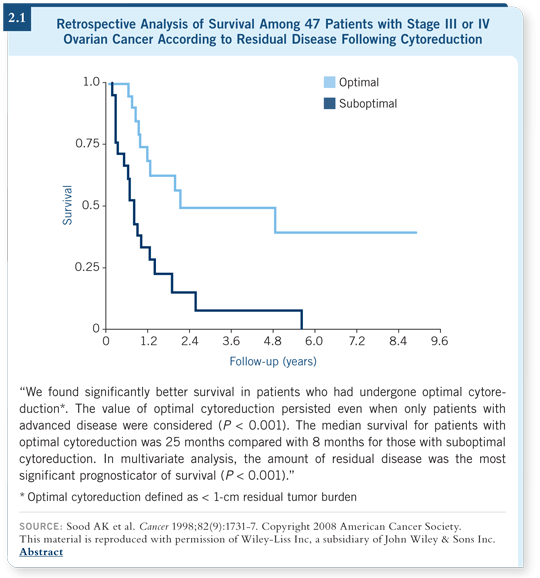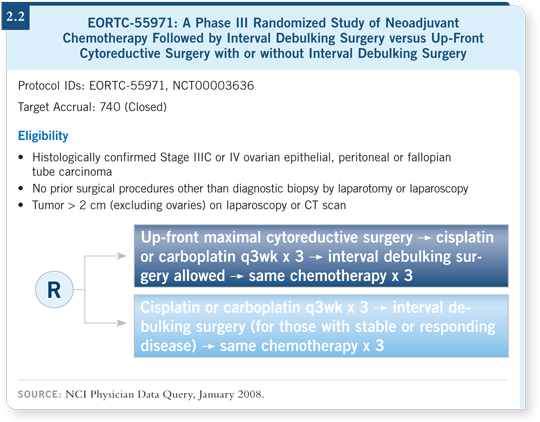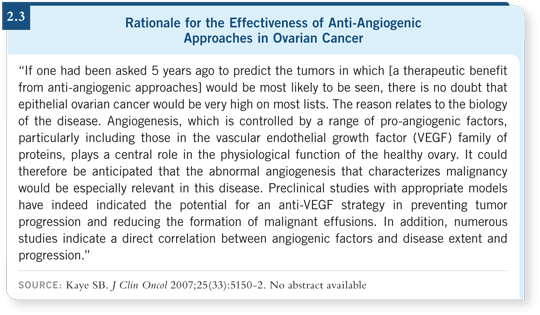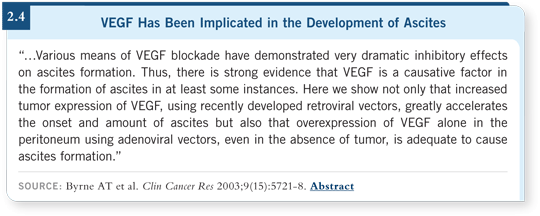
 |
|||||

| Tracks 1-17 | ||||||||||||||||||||||||||||||||||||
|
Select Excerpts from the Interview
Tracks 5-6
![]() DR LOVE: You recently wrote an editorial about optimal surgical
cytoreduction in the Journal of Clinical Oncology (Markman 2007). Can
you discuss your thoughts?
DR LOVE: You recently wrote an editorial about optimal surgical
cytoreduction in the Journal of Clinical Oncology (Markman 2007). Can
you discuss your thoughts?
![]() DR MARKMAN: Ovarian cancer is an interesting malignancy from the perspective
of its extraordinary sensitivity to chemotherapy, which has been recognized
for a long time: 60 to 80 percent of patients achieve a major objective
response. In fact, if one were to routinely perform second-look laparotomies — this was done in the past and is not done now, but we have a lot of data on
it — half of the women who had optimal residual ovarian cancer would have
no evidence of disease at the time of the second-look surgical procedure.
DR MARKMAN: Ovarian cancer is an interesting malignancy from the perspective
of its extraordinary sensitivity to chemotherapy, which has been recognized
for a long time: 60 to 80 percent of patients achieve a major objective
response. In fact, if one were to routinely perform second-look laparotomies — this was done in the past and is not done now, but we have a lot of data on
it — half of the women who had optimal residual ovarian cancer would have
no evidence of disease at the time of the second-look surgical procedure.
![]() DR LOVE: Is this a pathologic complete response?
DR LOVE: Is this a pathologic complete response?
![]() DR MARKMAN: Yes. So on the one hand, this is a remarkably chemotherapy-sensitive
disease. On the other hand, the vast majority of these patients are not
cured.
DR MARKMAN: Yes. So on the one hand, this is a remarkably chemotherapy-sensitive
disease. On the other hand, the vast majority of these patients are not
cured.
Because of the chemotherapy sensitivity and because of the fact that the disease was recognized many years ago as having a better prognosis when the disease was smaller at the start of chemotherapy (Griffiths 1975), the standard approach in the gynecologic cancer community has been to try to resect as much disease as possible prior to the administration of chemotherapy. Strong retrospective data support this (Sood 1998; Bristow 1999): If you review all of the studies’ meta-analyses, you will find more favorable prognoses for women with the smallest volume of disease (including what is now called zero volume or no residual disease) before beginning chemotherapy (2.1).

The problem with all of these analyses is that no randomized trial has ever examined the question of chemotherapy alone versus chemotherapy followed by surgery — the so-called neoadjuvant approach — versus standard surgery followed by chemotherapy.
![]() DR LOVE: Are there alternatives to up-front surgery for patients with ovarian
cancer?
DR LOVE: Are there alternatives to up-front surgery for patients with ovarian
cancer?
![]() DR MARKMAN: The alternative would be to consider the neoadjuvant
approach — making a diagnosis of ovarian cancer with laparoscopic surgery,
followed by the use of effective chemotherapy, which currently includes a
platinum and a taxane.
DR MARKMAN: The alternative would be to consider the neoadjuvant
approach — making a diagnosis of ovarian cancer with laparoscopic surgery,
followed by the use of effective chemotherapy, which currently includes a
platinum and a taxane.
After three cycles of therapy in a responding patient, one could attempt surgical cytoreduction, then go on and administer further chemotherapy. This approach has been accepted by some surgeons but not by the majority in the US.
A prospective randomized trial addressing this question in Europe (EORTC-55971) has completed accrual. This EORTC study is evaluating a neoadjuvant approach versus surgery followed by chemotherapy (2.2).
It has shown no differences in outcome, so it may challenge the practice of performing aggressive surgery on all patients initially. From what I understand, we won’t have the survival data for several years.

Track 10
![]() DR LOVE: Would you discuss your thoughts on the mechanism of action
of bevacizumab in ovarian cancer?
DR LOVE: Would you discuss your thoughts on the mechanism of action
of bevacizumab in ovarian cancer?
![]() DR MARKMAN: A lot of speculation has occurred regarding why bevacizumab
is so active in this tumor type (2.3). In particular, bevacizumab seems to be
extremely effective in controlling malignant ascites (Byrne 2003; Hu 2005;
Xu 2000; Wright 2006). Anecdotal data suggest that if you administer bevacizumab,
the tumor may not shrink. So the effects of bevacizumab may not be
associated with what you would consider an objective response, but the ascites
is well controlled in some of these patients for a long time (2.4).
DR MARKMAN: A lot of speculation has occurred regarding why bevacizumab
is so active in this tumor type (2.3). In particular, bevacizumab seems to be
extremely effective in controlling malignant ascites (Byrne 2003; Hu 2005;
Xu 2000; Wright 2006). Anecdotal data suggest that if you administer bevacizumab,
the tumor may not shrink. So the effects of bevacizumab may not be
associated with what you would consider an objective response, but the ascites
is well controlled in some of these patients for a long time (2.4).
You often see tumor markers drop. The patients don’t get better, but this raises the question of what we’re observing with bevacizumab in ovarian cancer. In ovarian cancer, the hypothesis is that this is less of an effect on the cells directly and more of an effect on interstitial pressure of the tumor.


Bevacizumab seems to be additive to or synergistic with chemotherapy. If it decreases interstitial pressure in the tumor microenvironment, it allows high concentrations of drug to reach the tumor and could also cause more tumor cell kill. This is completely speculative, but it is an interesting hypothesis that makes some sense.
| Table of Contents | Top of Page |
EDITOR
Neil Love, MD
INTERVIEWS
Robert F Ozols, MD, PhD
- Select publications
Maurie Markman, MD
- Select publications
Thomas J Herzog, MD
- Select publications
Ovarian Cancer Update:
A CME Audio Series and Activity